These instructions are used to prepare a fresh server for deployment as a Guru Server. These instructions are intended for Roos Instruments employees and service technicians. Guru Server is hosted on xbuntu LTS with xbuntu-desktop as the UI on any ubuntu supported PC hardware. Guru requires UI to interact with the non-OS features directly on the server.
Known working versions "Ubuntu LTS": 16.04, 18.04, 20.04 (see
Topics included below explain the procedure to prepare the default OS installation for Guru Server. Servers can be accessed using the local workstation (monitor and keyboard) or remotely via RDP/VNC (remote desktop UI) or SSH (command line). When possible both command line and GUI instructions are provided. Instructions not provided below can be found by searching online for "<topic> ubuntu" to access a vast amount of information.
Network Time Protocol (NTP) is required for accurate reference time in GMT for Guru to function correctly. When a guru client makes a connection to a guru server, and the GMT is different, the client will assume the Guru Server time for all timestamps.
Topics Covered: Deploy Xubuntu, Install Oracle Java and xrdp, Install Guru Server Server Administration, Remote Desktop, Network Settings, NTP Settings, Timezone, Mount Shared Network Drives (NFS), Shared Folders, Change OS Update Country, OS Update, Guru Server Launch Script, Identify Guru Server Version, Hardware Monitoring.
Get Xubuntu:
1. Download Latest Xubuntu LTS release, 64-bit ( https://xubuntu.org/getxubuntu/ )
2. Install via USB. (Search google for "iso to usb" or try http://www.isotousb.com/ )
Suggested options: username = guru, autologon, default installation options, if you have questions, contact [email protected]
 GuruEnterpriseInstall-Step1.png
GuruEnterpriseInstall-Step1.png GuruEnterpriseInstall-Step2.png
GuruEnterpriseInstall-Step2.png GuruEnterpriseInstall-Step3.png
GuruEnterpriseInstall-Step3.png GuruEnterpriseInstall-Step4.png
GuruEnterpriseInstall-Step4.png GuruEnterpriseInstall-Step5.png
GuruEnterpriseInstall-Step5.png GuruEnterpriseInstall-Step6.png
GuruEnterpriseInstall-Step6.png GuruEnterpriseInstall-Step7-coffee break.png
GuruEnterpriseInstall-Step7-coffee break.pngIf installing on a VM, install the appropriate Guest OS services (i.e. "VBoxGuestAdditions" for VirtualBox)
 GuruEnterpriseInstall-Step8-VboxGuestAdditions(optional).png
GuruEnterpriseInstall-Step8-VboxGuestAdditions(optional).pngInstall Dependancies & Setup Remote Access
Guru server requires the following additional packages: Java (OpenJDK 11 or later), tcsh for guru launch script, ntp for network time, 32bit libs.
1. Install dependancies, open a terminal and type:
sudo dpkg --add-architecture i386
sudo apt update
sudo apt install openjdk-11-jdk tcsh ntp lib32gcc1 libc6:i386
sudo apt install libxm4:i386
(if package libxm4 not found, wget http://archive.ubuntu.com/ubuntu/pool/universe/m/motif/libxm4_2.3.8-2build1_i386.deb then apt install ./libxm4_2.3.8-2build1_i386.deb)
/****************************************
/* for ubuntu 20.04, libxm4:i386 is missing
/* get it from the 18.04 version, libxm4_2.3.8-2build1_i386.deb
/****************************************
$ sudo dpkg --add-architecture i386
$ sudo apt update
$ sudo apt install -y libc6:i386
$ sudo dpkg -i libxm4_2.3.8-2build1_i386.deb
$ sudo apt install -f -y
1. (Optional) Configure Remote Desktop - If running via a VM like VirtualBox or VM Ware, use the vm platform's remote capabilities - i.e. vbox rdp)
sudo apt install xrdp
Configure XRDP: https://azure.microsoft.com/en-us/documentation/articles/virtual-machines-linux-classic-remote-desktop/
NOTE: TeamViewer may also be installed to facilitate for remote RI support.
2. (Optional) Disable crash reporting.
sudo nano /etc/default/apport, set enabled=0
3. (Optional) Install VirtualBox Guest Additions (Oracle LICENSE REQUIRED, adds support for USB 2.0 and USB 3.0 devices, VirtualBox RDP, disk encryption, NVMe and PXE boot for Intel cards.)
https://askubuntu.com/questions/22743/how-do-i-install-guest-additions-in-a-virtualbox-vm
4. (Optional) Remove all non-essential Ubuntu packages (like open office) to save time performing updates and reduce HDD footprint.
sudo apt-get remove libreoffice-common gstreamer
5. Reboot the OS.
Install Guru Server
1. Copy the install package (tar.gz) and Guru ID (.zip) to the host user's home directory (note: company specific <<guru_id>>.vfd may be packaged in the .tar.gz)
scp gSrv##-l-<<Company>>.tar.gz <<guru_id>>.zip guru@<hostname>
2. Unpack program (and guru ID) in the /home/<user> directory:
tar -xvf gSrv##-l-<<Company>>.tar.gz
unzip <<guru-id>>.zip
3. Prepare Guru ID. Add guru user to 'disk' group and create loopback floppy device for guru key. GuruServer defines it's identity from this loopback device when the server starts.
sudo usermod -a -G disk <<username>>
sudo mkdir /media/floppy
4. Mount GuruID loopback "floppy" drive manually:
sudo mount -t vfat -o loop /home/<<username>>/<<guru-id>>.vfd /media/floppy
And at startup.
sudo nano /etc/fstab
append the following line to the end of the file:
/home/guru/<<guru-id>>.vfd /media/floppy vfat user,loop 0 0
then press CTRL+X, Y, enter to save the file.
5. Create Autostart entry with Settings > Session and Startup > Application Autostart tab > +Add button, with "Guru Server" name, any helpful description, and command = /home/guru/riApps/guruServer/guruServerStart.sh -RiRootGuru
note: .sh script performs automatic updates (when manually imported into guru via .gzp or replace guruServer.zip) and will automatically restart Guru if System > Shutdown or process terminated.
6. Restart the server and confirm Guru UI appears. Confirm GuruID by choosing Login button, the Guru ID is displayed in the UserName prompt, use "roos inst" and "cathy" and continue setup.
7. Configure Guru Server settings by launching the Apps > Guru Address Book Admin > Check View Local Addresses > Select Title=<<guru_id>> > Edit Selected. Adjust the Remote Pipes to 32 or to match the number of clients expected + 2 (for overhead), then press Save. Restart Guru by selecting System > Shutdown. It will automatically restart after a few moments. Local/Remote Pipe configuration defaults to 32 or 2x number of Cassini Systems + Virtual Workstations, limited by system resources: RAM, CPU and Ethernet interface.
8. Guru should now be accessible from Cassini ATE and Virtual Workstation (via tcp port 50000) - Test by setting up a Cassini Tester or VM with an update/backup connections to the newly deployed server.
9. (Optional) Continue setting up the Guru domain (users/permissions)
See Connect to Guru Server with Guru Address Book https://roos.com/docs/RBEH-8WDMHY
See Initialize Guru Domain & Create Users https://roos.com/docs/RBEH-97PUXM
 GuruEnterpriseInstall-Step9.png
GuruEnterpriseInstall-Step9.png GuruEnterpriseInstall-Step10.png
GuruEnterpriseInstall-Step10.pngServer Administration
There are multiple interfaces used to administer Guru Server. 1) Monitor/Keyboard/Mouse. 2) Graphically via Remote Desktop (rdp). 3) Terminal session via SSH. Password is required for RDP access (vs SSH which can use a cert).
Default username/password = guru/****UNIQUE****
(note: SSH prevents "root" logon, use "guru" then prepend commands with "sudo")
Best security practice is to use both SSH cert to create a local tunnel for the RDP client as well as a sufficiently complex password.
Remote Desktop
The the ONLY way to interact directly with GURU is via a GUI from attached Monitor/Keyboard/Mouse or remote terminal (RDP). The command line interface (terminal or ssh) can only be used for OS activities. Command line interface can be opened via the local and remote terminals, however SSH is recommended for best remote admin performance.
Use a Remote Desktop client to connect to "<hostname>:3389" and enter the user credentials to access GUI.
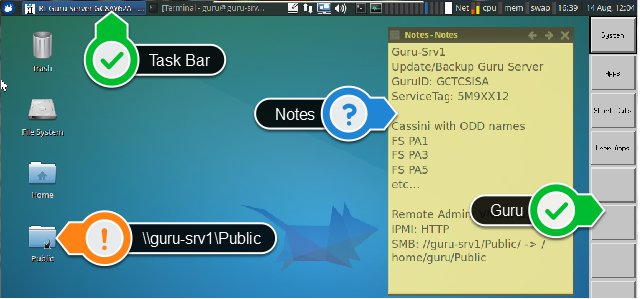

Since many of the configuration changes do not have a graphical user interface. Use "sudo mousepad /path/to/file" from a terminal to open a graphical based text editor.
From a command line: "ssh guru@<hostname>" and follow "from Terminal" instructions (where available).
Network Settings (IP Address, DNS, host name, etc.)
"NetworkManager" is used to connect to LAN. LAN is managed by company IT. See also Xubuntu Documenation - Network Connections.
From Desktop:
- Click on the NetworkManager icon in the task bar. Click "Edit" to change settings, "Information" for IP address information. Follow the dialog prompts to make any changes.
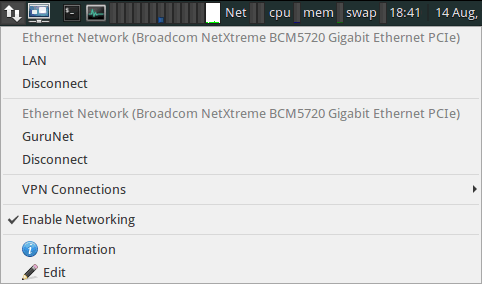
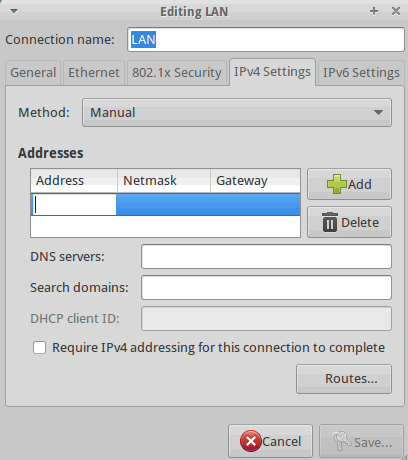
From Terminal:
- "sudo nano /etc/NetworkManager/system-connections/LAN"
For Static IP: edit "[ipv4]" to include "method=manual" and "address1=10.0.0.1/24,10.0.0.1" (address/net, default route)
Proxy Setting
Collect your network's proxy information. There may be differences between HTTP, HTTPs and FTP. replace "localaddrses" with the IP address of your machine, and ".localdomain.com" with your domain's global DNS.
From Terminal: "sudo nano /etc/environment", add the following lines. Note: You must duplicate upper case and lower case because some programs only look for one or the other.
- http_proxy=http://myproxy.server.com:8080/
https_proxy=http://myproxy.server.com:8080/
ftp_proxy=http://myproxy.server.com:8080/
no_proxy="localhost,127.0.0.1,localaddress,.localdomain.com"
HTTP_PROXY=http://myproxy.server.com:8080/
HTTPS_PROXY=http://myproxy.server.com:8080/
FTP_PROXY=http://myproxy.server.com:8080/
NO_PROXY="localhost,127.0.0.1,localaddress,.localdomain.com"
Some newer GTK3 programs rely on the Gnome settings instead. To make sure they are covered, open a terminal and paste the modified lines below, one at a time:
- gsettings set org.gnome.system.proxy mode 'manual'
gsettings set org.gnome.system.proxy.http host 'myproxy.server.com'
gsettings set org.gnome.system.proxy.http port 8080
- Acquire::http::proxy "http://myproxy.server.com:8080/";
Acquire::ftp::proxy "ftp://myproxy.server.com:8080/";
Acquire::https::proxy "https://myproxy.server.com:8080/";
NTP Setting
From Terminal: "sudo nano /etc/ntp.conf", update "server <hostname>" where <hostname> is the IP address or host name of the local NTP server..
See also Ubuntu Official Documentation - Time Synchronization with NTP.
Timezone
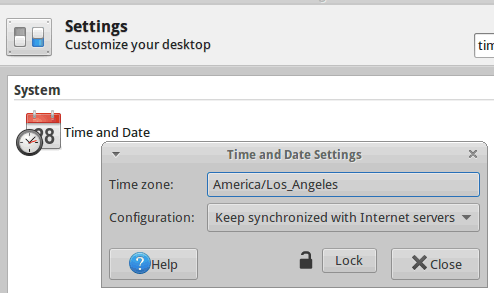
First click "Unlock", enter password, then click on the "Time zone:" field to select the appropriate time zone.
See also Ubuntu Community - UbuntuTime.
Mount Shared Network Drives (NFS or SMB)
IMPORTANT: /RiGuru and /RiApps should NOT be hosted on a remote NSF server without proper tuning.
From Terminal: "sudo nano /etc/fstab"
- Then add a line with this general syntax to connect to NFS server.
example.hostname.com:/ubuntu /local/ubuntu nfs rsize=8192,wsize=8192,timeo=14,intr
Then add a line with this general syntax to connect to SABMA or Windows server.
//myserver_ip_address/myshare /media/samba_share cifs credentials=/etc/samba/user,noexec 0 0
Shared Folders (Samba)
From Terminal: "sudo nano /etc/samba/smb.conf" Modify [global] or [Public] with changes.
See also Ubuntu Official Documentation - Samba
If running on VBox host, install Guest Additions then run "sudo usermod -G vboxsf -a $USER" to enable access to sf_ drives
Change Software Update Country
NOTICE: Regular software updates are NOT recommended. You SHOULD apply urgent security updates regularly or when requested by Roos Support.
Software updates are configured for United States. To improve update performance, change "Download From" to your country name.
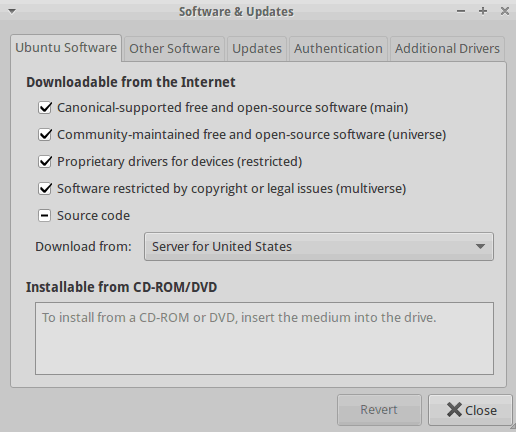
From the Updates tab, uncheck "Recommended" and "Unsupported" from the Updates tab to only include important security updates.
See also Xubuntu - Managing installed applications
OS Software Update
Notice: Security updates should be applied, unless instructed by Roos Support, regular updates do not need to be applied for reliable functionality.
With a internet connection to port 80 & 443 (https), software update dialog will appear based on the frequency it is set to check.
Update can be run anytime:
See also Xubuntu - Managing installed applications
Guru Server Launch Script
Guru Server requires a GUI (X) session to be running, so the "guru" user is set to autologin and Guru Server is set to start from the Xfce Application Autostart settings. DO NOT change these settings unless instructed by Roos Instruments. This information is provided for disaster recovery purposes only.
Guru Server is launched from the
Select "RI Guru Enterprise Server (Roos Instruments Guru Server)" and press Edit. Command = "/home/guru/RiApps/guruServer/guruServerStart.sh"

"guru" user is set to automatically log on via configured file "/etc/lightdm/lightdm.conf" under the "[SeatDefaults]" section.
Identify Guru Server Version
Identify the version of Guru Server that is currently running by hovering over the "[RI Guru Server..." task along the Task Bar.

Determine the OS version with "lsb_release -a" command.

